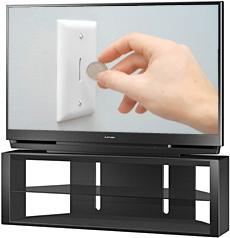 Question: On my Mitsubishi TV I have the option of "Fast Power On" or "Low Power." Fast Power On brings the the video up very fast and Low Power takes some time. They say that Low Power uses less energy, but TV power-on takes longer and some TV features may be unavailable.
Question: On my Mitsubishi TV I have the option of "Fast Power On" or "Low Power." Fast Power On brings the the video up very fast and Low Power takes some time. They say that Low Power uses less energy, but TV power-on takes longer and some TV features may be unavailable.
What I am wondering is if I use the Low Power setting, would that extend my bulb life?
-submitted by Brandon C
Answer: Given the way that feature is worded and presented in the Mitsubishi TV's menu, I can see how it can be confusing. On other TVs I've used in the past, particularly with LCD, Plasma, and CRT sets, a low power mode often indicates that it's driving the image with less brightness and contrast, and thus operating using less electricity.
In Mitsubishi's case however, this is not true. Their Low Power / Fast Power On mode refers to how much electricity the TV uses while in stand by, not operating. Modern day televisions are commonly referred to as power or electricity 'vampires' since they continue to draw power from the wall even when off to support some of the various electronic doo-dads, like the clock or your video settings for example.
Mitsubishi's Low Power mode comes with some caveats. When operating in Low Power mode, there will be some features or functions that won't operate. These are:
- You can't do recordings to an IEEE 1394 device while the TV is off.
- You can't schedule future IEEE 1394 recordings for a time when the TV will be off.
- You can't using the TV Timer function to turn on the TV at a preselected time.
- The TV clock won't remain accurate for the TV Timer and for scheduling recordings. With the Low Power setting, you must reset the TV Clock if the TV is left turned off for over 48 hours.
- You won't receive receive updates to the ChannelView channel listings.
- Note: if you use a CableCard, you won't have the option to use the Low Power mode.
- Using Low Power mode increases the boot up time.
As an advocate for a greener world, I would typically recommend taking advantage of energy savings. According to other reports online, the typically savings is in the neighborhood of around 10 to 12 watts between the two modes, which could equate to $15-20$ per year on your electric bill.
Many of the features disabled by this mode could be things you don't even use (besides the clock). If that's the case, and you can handle some additional start up time, it may very well help you save a little bit of coin.
For your lamp, however, it won't affect it in the slightest.
Have a technology question? Join the TechLore Community and Ask The Experts today!
Learn More About Televisions and Projectors at TechLore | See More Ask The Experts Answers





Comments
Dang, I was hoping it would
Dang, I was hoping it would help save my bulb life. I go through bulbs about every 6 months and they are alot more expensive than the electric bill I would save yearly.
Thanks for the help. This answered alot!
that i why it has such a high
that i why it has such a high failure rate. basicly what the powersavr does is in th off mode it disconnects heDM stndby voltage turnd off goin to th DM voltge going to th DM so it is not running. if the power saver is turned on then there is notalways a voltage on in the a standby voltage power supplyapplid to th DM< when you tun on the power switch the miccroprocessesor tuns on the standby power supply to th dm. when the power switch is pressed the microprocesor turns on th standby power supply to thr DM and the BOOT proces stsrts. thst is where the micro and the DM comunicates and sets all functions and sved settings, this tskes about 60 to 70 seconds for the boot proes to run. if te DM and the micro doe not comunicate prpopely, the set wil not start up propely. after they do comunicate, the set then goes throuh anothr ompletete boot up procesc agin about 70 ecounds. This is why a lot of folks say it takes twice as long a it used to, as chris also explained in the power saving mode there are several functions that do not oprate properly. this simply turns off the power up voltage to the DM board whch is always on and drawing power. there is a large debate on what mode is best to use it on. I use the non power saver as I have a coolong fan attached to my DM to keep it cooled down I relly do not think it saves all that much eletricity in the long run, some ay the high failure rate of the dM cpacitors Is because of they are always on, I personally think th high falure rate of the caps in th dm is not because hey are on all the time, but because of the small power surge created when the power supply is switchd on while in th power saving mode.I am certainly not an engeineer but This is only my opioion.like I said the THE v23TRaining manual explains it in a great technical way it is like on the old tube TV ts that had no warm up time because the set had the tubes always on and heatd up already. so when power was applied they th ube were already to go.hope this explains a little to those interested.